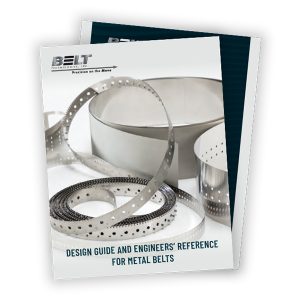Heat tolerance and resistance to chemical corrosion make stainless steel a popular choice for automated equipment used in cooking, sterilization, and pasteurization. Many manufacturers select wire mesh belts stainless conveyors due to their low upfront cost, however training, maintenance, inspection equipment, and frequent repair and replacement can drive real costs well above expectation, exceeding solid stainless alternatives.
Endless solid metal conveyor belts by Belt Technologies offer advantages that save manufacturers time and money. Our engineers design custom conveyor systems for each application with solid, stainless steel belts which improve operational efficiency and product quality. Replacing wire mesh with solid stainless steel belts offers a long lasting solution to the complications, expenses, and supplementary equipment required to operate and maintain wire mesh belted conveyor systems.
Reduced Maintenance Downtime for Maximum Efficiency
Mesh metal belts can often require maintenance and repair more frequently than solid metal conveyor belts. The linkages of a mesh structure provide hundreds, often thousands, of potential breakage points that need careful inspection and maintenance. The sprocket teeth of the belt must be painstakingly aligned to operate smoothly together; otherwise, individual strands of the wire mesh may become overstressed and fray or break. Stopping production to remove the belt and inspect it for damaged or broken links can add up to significant losses.
Solid stainless steel conveyor belt systems have fewer moving parts. This reduces the risk of mechanical failure, as well as downtime required for repairs and inspections. Conveyor systems by Belt Technologies are designed for easy access in both cleaned-in-place (CIP) and cleaned-out-of-place (COP) procedures, saving time on the production floor and allowing for maximum efficiency and product throughput.
Minimize the Risk of Product Contamination
In regulated industries, such as food processing or pharmaceutical production, wire mesh belts can impose extraordinary challenges on manufacturers. Transporting certain raw foods, such as poultry and fish, requires attention to hygiene standards to prevent product contamination. Fats, salts, grease, cleaning chemicals, and other environmental contaminants can migrate along the linkages of mesh metal belts. This bacterial buildup increases the risk of infectious outbreaks among consumers, and once built up in difficult-to-reach areas, these substances are costly and time-consuming to remove.
The linkages of a mesh metal belt create additional health risks as well. Many moving parts create an increased risk of small metal pieces breaking off and contaminating product. To address this potential hazard, facility managers must employ additional safety and damage-prevention procedures involving x-rays, necessitating extra training for staff. In worst-case scenarios, products contaminated with metallic debris that is not detected on-site can end up in the hands of consumers, which may result in potential injury, as well as FDA audits, penalties and sanctions.
In contrast, solid stainless steel conveyor belts:
- Do not fray or generate particulates.
- Do not require lubrication.
- Provide a flat, nonporous surface that will not harbor bacteria.
- Are highly resistant to impacts and abrasion, preventing scratches or divots.
- Are designed to be easily accessible, making sanitization a simple process that does not require excessive downtime.
- Withstand intense cleaning methods, including hot pressure washing, steam pressure washing, or chemical spraying.
Superior Conveyor Belt Integrity
Tension, heat, and high-impact processing methods can stress individual wire strands, causing their links to fail. To combat this problem, some mesh belts utilize thicker gauges of wire or small die-cut components; the additional material required to reinforce the links will increase the total weight of the belt. Solid metal belts, like those offered by Belt Technologies, provide the optimal strength-to-weight ratio for most automated operations. With correct load tension, solid stainless steel belts will not stretch, providing a longer-lasting, more durable belt.
Minimal Risk of Operator Error
The difficulty of maintenance, inspection, and replacement increases proportionally to the number of small, individual parts in a belt. One of the most common causes of failure occurs when mesh metal belts are removed for cleaning or inspection and subsequently re-installed and connected incorrectly. Improper joining of the belt ends can lead to immediate breakdowns and breakages during production. If the belt is installed upside down or backwards, which happens more often than you might expect, the entire system can be damaged.
Solid belts are easy to replace, if necessary, and many routine maintenance and cleaning operations can be performed without removal of the belt, decreasing opportunities for operator error. In many scenarios, solid stainless steel belts do not need to be removed from the system for sanitization or inspection, saving hours of downtime.
Solid stainless belts by Belt Technologies are clean and chemically inert, simple to operate, and easy to maintain. How can your conveyor system benefit from the superior advantages of solid, stainless steel belts? Contact the experts at Belt Technologies today!



